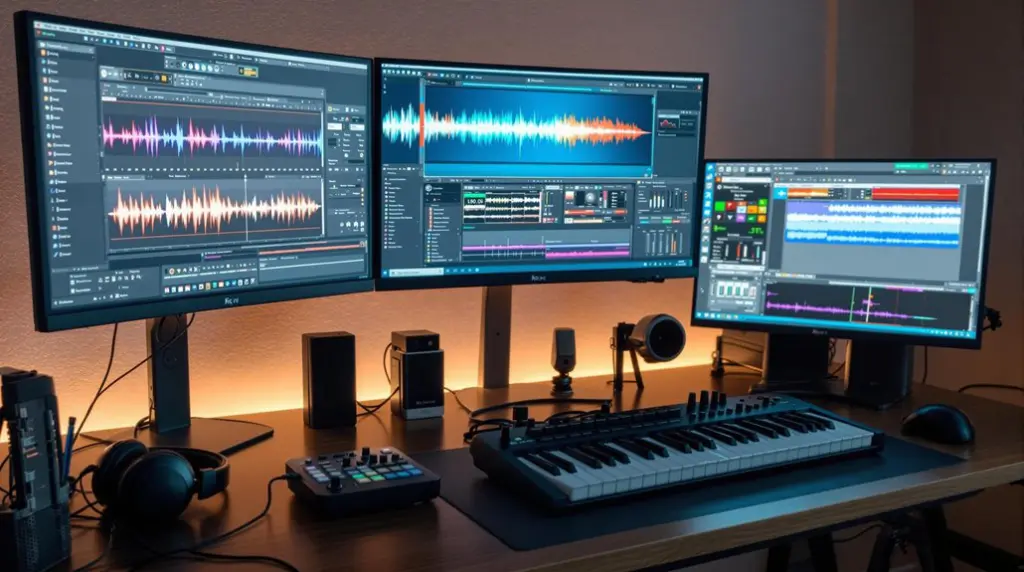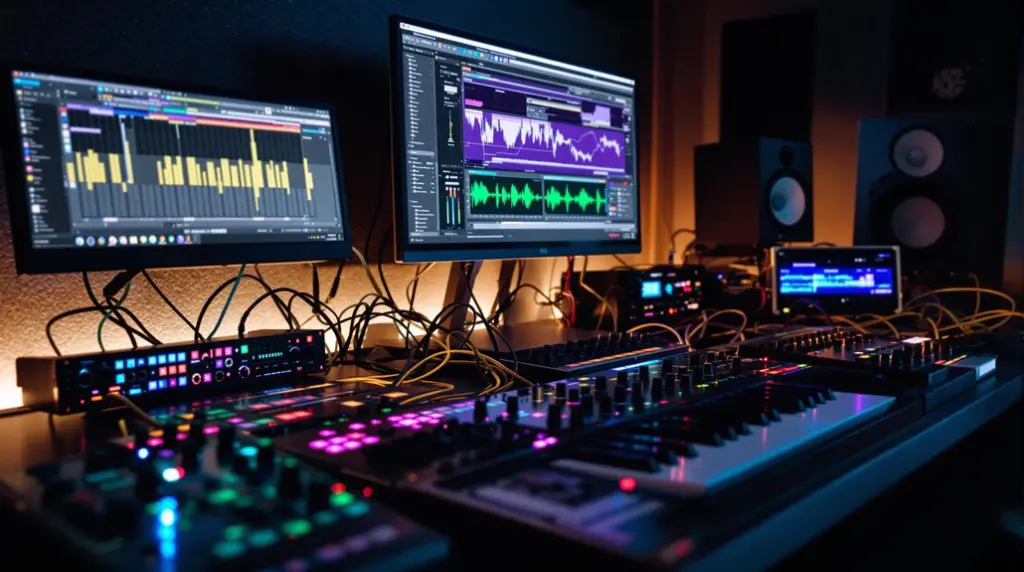The Roland JX-3P synthesizer is highly regarded for its advanced 16-step sequencer, which supports intricate basslines, transpositions, and note layering, enhancing live performance versatility. It also boasts a 24dB/octave low-pass filter and an onboard chorus effect, delivering a rich tonal palette and distinctive vintage yet modern sounds. Market value has surged markedly, with clean units now fetching between $800 and $1500, reflecting its status as a collectible and prized instrument among musicians and collectors. Those interested in exploring the full extent of its capabilities and market dynamics will find further insights highly beneficial.
Key Takeaways
- Built-in 16-step sequencer allows for intricate basslines and melodies.
- 24dB/octave low-pass filter provides a rich tonal palette.
- Onboard chorus effect enhances sonic depth, ideal for electronic genres.
- Sequencer layering creates complex soundscapes for engaging performances.
- The market value has surged, often exceeding $800, with forecasts up to $1500.
Sequencer Capabilities
The Roland JX-3P’s sequencer capabilities stand out as a cornerstone feature, particularly remarkable for its built-in 16-step sequencer designed for programming intricate basslines and melodies. This sequencer facilitates precise step programming, enabling musicians to input notes individually and adjust them meticulously.
The dedicated button for transposing sequences allows for seamless modulation, providing flexibility to modify musical phrases on the fly, a vital requirement for dynamic live performances and improvisation.
A distinguishing aspect of the JX-3P’s sequencer is its support for note layering. This function permits the addition of multiple notes over existing sequences, enriching the harmonic and melodic content of compositions. Such versatility transforms simple sequences into complex, textured arrangements, enhancing the creative capabilities of the user.
Additionally, the sequencer’s ability to sync effortlessly with drum machines makes it ideal for crafting the rhythmic and melodic foundations characteristic of 80s Italo Disco and other electronic music genres. The Roland JX-3P, much like the sound libraries found in modern DAWs, encourages experimentation and sound refinement.
Compared to similar models, the JX-3P’s sequencer offers superior versatility and engagement in both studio and live settings. Its intuitive step programming and note layering features combine to deliver a robust, user-friendly experience, solidifying its status as a go-to instrument for electronic music enthusiasts.
Sound and Performance
Building on its robust sequencer capabilities, the Roland JX-3P also excels in sound and performance, showcasing a resonant 24dB/octave low-pass filter that contributes greatly to its rich tonal palette. This filter resonance is essential in shaping the JX-3P’s sound quality, enabling the production of lush pads and fat bass sounds that are both warm and full-bodied. The onboard chorus effect further enhances the sonic depth, though it should be used judiciously to prevent noise interference.
The JX-3P’s sound design capabilities are expansive, offering the creation of unique textures that span spacey pads to punchy basslines. This versatility makes it suitable for a variety of musical styles, from ambient to electronic. Users can layer notes over sequences, adding complexity to their performances and creating intricate soundscapes.
Below is a summary of the key sound and performance features:
| Feature | Benefit | Use Case |
|---|---|---|
| 24dB/octave Filter | Rich, warm sound quality | Lush pads, fat bass sounds |
| Onboard Chorus Effect | Enhanced sonic depth | Adds depth, use sparingly |
| Sequencer Layering | Complex soundscapes | Engaging performance |
| Sound Design Versatility | Unique texture creation | Spacey pads, punchy basslines |
The JX-3P’s ability to produce distinctive metallic and clear sounds further distinguishes it, delivering a vintage character that retains a modern edge.
Market and Availability
With increasing demand in recent years, the Roland JX-3P has experienced a notable surge in market value, often commanding prices above $800 and with forecasts suggesting potential highs of $1500. This significant appreciation underscores the unit’s vintage appeal, positioning it as a highly coveted item among synthesizer enthusiasts.
Historically, the JX-3P was considered an affordable alternative to its sibling, the Juno-60, with prices hovering around $300. However, the current pricing trends reflect a re-evaluation of its worth, further solidifying its reputation as a valuable classic.
The scarcity of available units has exacerbated the rise in prices, particularly for clean models and those with the accompanying PG-200 programmer. Such units often exceed $1,000, indicative of their growing rarity and desirability in the market.
Prospective buyers should be mindful of this trend, as the availability of the JX-3P is expected to decline further. Collectors and musicians alike are advised to act quickly to secure these synthesizers while they remain accessible.
Adjusted for inflation, the initial purchase price of the JX-3P would be approximately $3,000 today, emphasizing its increasing value not just as a musical instrument but also as a collectible asset.
Frequently Asked Questions
What Are the Specs of the Jx-3p?
The Roland JX-3P specifications include six-voice polyphony with three DCOs per voice, a 24dB/octave low-pass filter, and an LFO with multiple waveforms. It offers robust analog synthesis capabilities for intricate sound design and includes 64 patch memory locations.
When Did the Roland JX-3P Come Out?
The Roland JX-3P was released in January 1983, marking a significant point in synth evolution. Its introduction during this period contributed to its remarkable place in the release history of influential synthesizers.
Conclusion
In conclusion, the Roland JX-3P synthesizer showcases notable sequencer capabilities, robust sound and performance characteristics, and a competitive position within the market. Its integrated sequencer offers extensive programming potential, while its synthesizer engine delivers a diverse range of timbres suitable for various musical applications. Despite its vintage status, the JX-3P remains accessible and sought after in both new and used markets, making it a viable option for both professional musicians and synthesizer enthusiasts.




